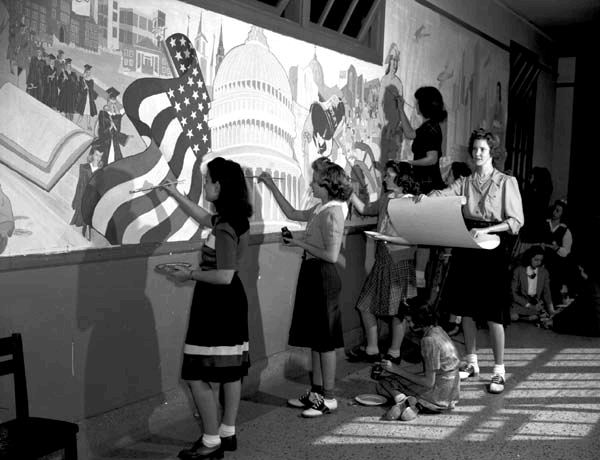|
Today in New Orleans History |
|
|
November 17


Eleanor McMain School The following descriptions
are from Podine Schoenburger's January 10, 1932 article. The colors described by Shoenburgburger don't match the modern-day
colors but give us a glimpse or what the building looked like so many years ago: The exterior of the stucco school building
was painted green. Schoenburger described the "strange colorful entrance" with vivid blue urns, one at each side
of the main door, in which century plants were growing. The carved tops of the white pillars flanking the doorway were painted
green and cold. The doors were of leaded glass with a basket of brightly colored flowers topping them. Green grinning
gargoyles topped them all, and above them the nameplate was blue with with gold letters spelling out the school's name amid
a pair of gold lions. High above the entrance of the three-story building are two sculptures by Albert Ricker. The first
depicted a young Acadian maiden in a blue dress, starched apron, and a spinning wheel at here feet to symbolize industry.
The second figure is of an older woman, with an owl as symbol of wisdom. As the girls
stepped inside onto inlaid terrazzo floors, two cream-colored curved staircases with carved balustrades and mahogany rails
could take them up the the principals office, the main office, or the teachers room. The principals office opened to a brightly
tiled, yellow-walled court yard with a blue, green, and yellow fountain, providing a "tropical atmosphere". On the third floor was a study hall which could accommodate 300 students. It was finished in green and buff
with full-length leaded glass doorways which led to an overhanging balcony. The classrooms were finished
in green, blue, and pink in a "modern style in perfect keeping with the personalities of the lithe creatures who will
people it". Each room had a telephone. Some large rooms could be divided by accordion doors which, when closed,
provided a series of blackboards. The building was equipped with radio and loudspeakers. Oscillating heaters were employed
on the ground floor; ventilation and heat throughout the facility were "modern to the nth degree" and there were
"many and generous windows". Natural lighting in the art room was provided by a central skylight.
There were hand dryers on each side of white wash basins. "Ducky little kitchens", each different, were designed
so that "one can learn to cook for a $15 a week clerk husband, a husband of moderate means, or a wealthy banker spouse".
The first was small with a tiny stove and diminutive sink -- "Girls will learn to manage a small apartment, so
that if they plan to live on love they will know how to feed hubby dear in cramped quarters, and on a slim income".
The second kitchen was larger, "to train for moderate housekeeping". The third had an "electric stove
and other luxuries that migh be found in a wealthy home". The auditorium"resembles a large
theater" with a saucer-shaped balcony, special switchboard for stage lighting, a projection booth "for showing both
silent and talking pictures", and an asbestos curtain side-draped with gold and blue velvet. It could accommodate 3000
people. There were four science labs, 40 classrooms, a 5000 book library, and a modern cafeteria in the building which measured
180 x 390 feet and was built at a cost of $550,000. This "colorful structure embodying many new ideas in education was
opened under the direction of Miss Alice A Leckert, principal". McMain opened its doors to the
public on Sunday, January 31, 1932 from 4 to 7 p.m. when a reception was hosted by the teachers. The 917 students' first
day was Monday, February 1, when the girls gathered in the auditorium for speeches by local dignitaries followed by a flag
raising ceremony with music provided by the Warren Easton band. Today Eleanor McMain Secondary School
is open to boys and girls in the 7th through 12th grades. Still under the direction of the Orleans Public Schools, it
has 769 students whose graduation rate is 95%.
The movie The Blind Side premiered on November 17, 2009 in New York City and New Orleans. Christ Church Cathedral, founded in 1803, located today at 2919 St. Charles Avenue became
the first Episcopal church to commission a jazz composition when it commissioned Irvin Mayfield
to commemorate Hurricane Katrina through a composition, titled "All the Saints", which
premiered on November 17, 2005, at the cathedral in conjunction with the bicentennial of Episcopal ministry
in New Orleans. The cathedral was first non-Roman Catholic church founded in the entire Louisiana Purchase
territory. Born in New Orleans on September 23, 1883, jazzman Wooden Joe Nicholas was an active
member of the early New Orleans jazz scene. He knew Buddy Bolden and said Bolden was the
main influence on his cornet style. In 1915 he was playing clarinet with King Oliver.
In addition to forming the Camelia Brass Band in 1918, he was famous for his volume and endurance. Nicholas did not
record until 1945 when he was 62 years old and again in 1949. He died in New Orleans on November 17, 1957.
He was the uncle of clarinetist Albert Nicholas.
In 1805 the Rev. Philander Chase came to New Orleans and organized the Christ Church Episcopal community which began worship in the Cabildo on November 17 of that year.
|
|
|

To receive an update for each day in New Orleans history,
join our facebook page - Today in New
Orleans History.
Analytics |




